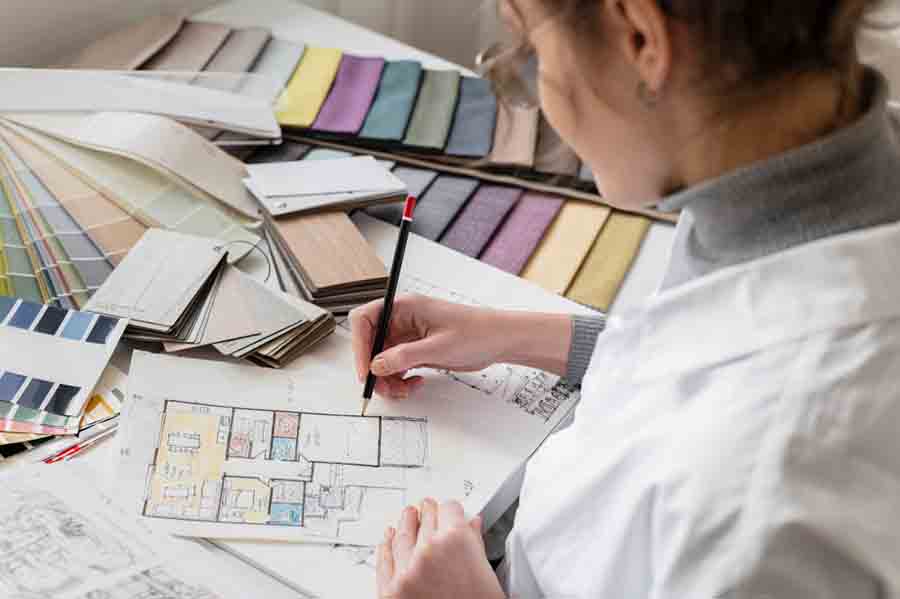by Graphic & Cadd
Share

Introduction
The interior design industry is a dynamic and ever-evolving field that plays a pivotal role in shaping the aesthetics and functionality of our living spaces. Over the years, this industry has witnessed significant transformations, driven by changing consumer preferences, technological advancements, sustainability concerns, and a growing focus on wellness. In this article, we will explore the evolution of the interior design industry, highlighting the latest trends and innovations that are shaping its future.
1. Sustainability Takes Center Stage
One of the most notable developments in the interior design industry is the growing emphasis on sustainability. As climate change and environmental concerns take center stage globally, interior designers are adopting eco-friendly practices and materials. From reclaimed wood furniture to energy-efficient lighting, sustainable design has become a significant trend. This shift towards sustainability not only benefits the environment but also creates healthier and more eco-conscious living spaces for occupants.
2. Technology and Smart Homes
Advancements in technology have revolutionized the way we design and interact with our homes. The rise of smart home systems, which include automated lighting, heating, and security, has given interior designers new tools to enhance both functionality and aesthetics. Integrating technology seamlessly into interiors has become an art, with designers collaborating with tech experts to create homes that are not only beautiful but also highly functional and efficient.
3. Biophilic Design
Biophilic design is a concept that incorporates nature into interior spaces. It recognizes the innate human connection to the natural world and seeks to create environments that promote well-being and reduce stress. Incorporating elements such as indoor plants, natural materials, and large windows that allow for abundant natural light and views of nature, biophilic design is gaining popularity for its ability to create calming and rejuvenating spaces.
4. Minimalism and Multifunctionality
The “less is more” approach to interior design has gained traction in recent years. Minimalism emphasizes clean lines, open spaces, and a clutter-free environment. This design philosophy not only enhances aesthetics but also encourages simplicity and mindfulness. Additionally, multifunctional furniture and spaces have become essential in homes where space is limited. Furniture pieces that can serve multiple purposes, such as sofa beds and folding tables, are becoming increasingly popular.
5. Personalization and Customization
Consumers today are seeking unique and personalized design solutions that reflect their individuality. Interior designers are responding to this demand by offering customized furnishings, finishes, and layouts. This trend not only allows clients to have a more significant say in the design process but also creates spaces that resonate with their personalities and lifestyles.
6. Inclusivity and Accessibility
Interior designers are increasingly recognizing the importance of creating spaces that are accessible to people of all abilities. Inclusivity in design involves considering the needs of individuals with disabilities and making spaces more accommodating. This includes features such as wider doorways, accessible bathrooms, and adaptive furniture, ensuring that everyone can enjoy a comfortable and functional environment.
7. Virtual Reality and 3D Rendering
Virtual reality (VR) and 3D rendering technology have transformed the way interior designers present their ideas to clients. These tools allow clients to experience their future spaces in immersive, realistic ways before any construction or purchases are made. This not only enhances communication between designers and clients but also reduces the risk of costly design errors.
Conclusion
The interior design industry continues to evolve, driven by changing consumer preferences, technological advancements, and a growing awareness of sustainability and well-being. As we move forward, the industry is likely to see further innovation in materials, construction methods, and design concepts. Interior designers will play a crucial role in creating spaces that not only look beautiful but also enhance the quality of life for their occupants, making the interior design industry a fascinating field to watch in the years to come.
STAY IN THE LOOP

